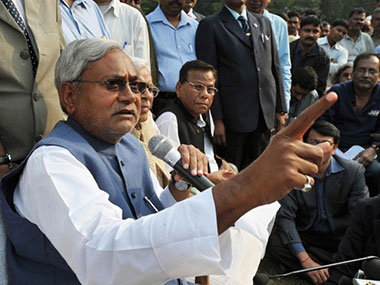The countdown for the Bihar assembly polls may have officially begun last week when the Election Commission announced the polling dates, but the real countdown began in February, when Arvind Kejriwal won the Delhi elections, handing the BJP its first, stinging defeat since May 2014. [caption id=“attachment_2425940” align=“alignleft” width=“380”]  Bihar Chief Minister Nitish Kumar. AFP[/caption] The reason why the pandits started the countdown earlier will never be stated honestly: most of them were anti-Narendra Modi, and the Delhi defeat gave them hope that he could be defeated. This is why they have been billing every subsequent election as something to do with Modi. Wins were credited to other factors (as the BJP’s local election wins in Madhya Pradesh and Rajasthan were despite Lalitgate and Vyapam), and the losses to Modi (Delhi, Kolkata Municipal Corporation). Delhi made Bihar relevant. This is why within days of Kejriwal’s crowning, Nitish Kumar toppled his own handpicked successor Jitan Ram Manjhi and seized the crown for himself. Thus, if the Bihar election is a test case for anyone, it is not Modi, but Nitish Kumar. Whatever be the result, Modi’s central government will continue to remain powerful; it is Kumar who faces the possibility of political oblivion if he loses, and the challenge of running a messy coalition government if he wins. Just as a three-legged race is not meant for pace or performance, Kumar will be permanently hobbled by Lalu Yadav. His victory - however remote the possibility - will be pyrrhic at best. For the BJP, on the other hand, the Bihar polls hold huge promise, win or lose. Reason: for the first time ever it has been able to cobble together an effective coalition of the upper castes, some OBCs and Dalits, enabling it to test the viability of this combo in national politics. While Muslims and Yadavs will be difficult to snare in this election, the rest of the communities could well swing the BJP’s way this time. If the BJP wins this time, even Yadavland will not remain closed to it. Here’s why Bihar is Advantage Modi. First, the BJP-led coalition seems less driven by pure caste and religion arithmetic and also has an anchor power in the BJP. The BJP is contesting 160 seats on its own, leaving 40 to Ram Vilas Paswan’s LJP and 20 to Jitan Ram Manjhi’s HAM. Another 23 goes to the OBC party, Upendra Kushwaha’s RSLP. This means the BJP could conceivably win a majority on its own (the halfway mark is 122), and, at worst, it may need small partners to run a coalition. In contrast, the 100:100:40 split in the rival camp between JD(U), RJD and Congress will guarantee a coalition with no dominant partner. If the RJD wins more seats than Nitish Kumar, he’s had it. In short, the electorate can see that the BJP-led coalition has a better chance of providing stability than the JD(U)-RJD combo. Bihar’s voters are unlikely to vote for instability. Second, the election is likely to be an acid test for Nitish Kumar - and his recent record has been nothing to write home about. All his moves have ended up alienating someone or the other. His break with the BJP in 2013 angered the upper castes, and his clumsy efforts to install Jitan Ram Manjhi as puppet chief minister in May 2014, and his sordid manoeuvres to get him sacked this February and reinstall himself as CM, could not have endeared him to Dalits. These unprincipled actions exposed Kumar’s charlatan politics. Third, with the focus now squarely on Kumar’s manoeuvring and poor recent performance, Modi will have a field day attacking him all through the campaign. This is a rare advantage for the BJP as it is not the party’s record in Delhi that will be the focus of the campaign, but Kumar’s alleged failures. This is where the five-phase election spread out over 24 days from 12 October to 5 November will help the BJP. Modi will be able to campaign in every part of the state by turn, increasing his effectiveness. He will have a field day attacking Nitish Kumar and Lalu Prasad without facing any attacks on his own performance at the centre - even though that performance has been better than the UPA’s last years on all economic parameters. The Bihar elections are about Bihar and Nitish - and Modi has the clear advantage here. Fourth, and most importantly, the BJP will be able to test its new electoral arithmetic for a rollout again in other states - especially Uttar Pradesh next year, where Akhilesh Yadav will be facing anti-incumbency and a similar caste combine could work. If the upper caste-Dalit-non-Yadav-OBC coalition carries the day in Bihar, UP can be next, especially as Dalits seem willing to desert Mayawati if offered a better deal by the BJP. For the BJP and Modi, Bihar will be a sample testing ground with few downsides. If they win, they gain stature and can carry the formula elsewhere. If they lose, they get to play powerful opposition to a divided JD(U)-RJD misalliance. The Modi government will face no threat whatsoever from any result Bihar produces on 8 November. It is Nitish Kumar who should be biting his fingernails. This is a battle he cannot afford to lose, but even if he wins, he will confront the nightmare of ruling with Lalu Yadav holding the reins from the backseat.
Whatever be the result, Modi’s central government will continue to remain powerful; it is Kumar who faces the possibility of political oblivion if he loses.
Advertisement
End of Article
Written by R Jagannathan
R Jagannathan is the Editor-in-Chief of Firstpost. see more


)
)
)
)
)
)
)
)
)



